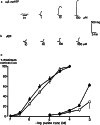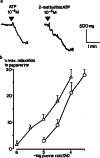That was then, this is now: the development of our knowledge and understanding of P2 receptor subtypes
- PMID: 33527235
- PMCID: PMC7954963
- DOI: 10.1007/s11302-021-09763-0
That was then, this is now: the development of our knowledge and understanding of P2 receptor subtypes
Abstract
P2 receptors are present in virtually all tissues and cell types in the human body, and they mediate the physiological and pharmacological actions of extracellular purine and pyrimidine nucleotides. They were first characterised and named by Geoff Burnstock in 1978, then subdivided into P2X and P2Y purinoceptors in 1985 on the basis of pharmacological criteria in functional studies on native receptors. Molecular cloning of receptors in the 1990s revealed P2X receptors to comprise seven different subunits that interact to produce functional homo- and heterotrimeric ligand-gated cation channels. A family of eight P2Y G protein-coupled receptors were also cloned, which can form homo- and heterodimers. Deep insight into the molecular mechanisms of agonist and antagonist action has been provided by more recent determination of the tertiary and quaternary structures of several P2X and P2Y receptor subtypes. Agonists and antagonists that are highly selective for individual subtypes are now available and some are in clinical use. This has all come about because of the intelligence, insight and drive of the force of nature that was Geoff Burnstock.
Keywords: G protein–coupled receptor; Heterodimer; Ligand-gated cation channel; P2 receptors; P2X receptors; P2Y receptors.
Conflict of interest statement
The author declares that he has no conflict of interest.
Figures







References
-
- Lohmann K. Über die pyrophosphate fraktion im muskel. Naturwiss. 1929;17:624–625. doi: 10.1007/BF01506215. - DOI
-
- Burnstock G. A basis for distinguishing two types of purinergic receptor. In: Straub RW, editor. Cell membrane receptors for drugs and hormones: a multidisciplinary approach. New York: Raven Press; 1978. pp. 107–118.
MeSH terms
Substances
LinkOut - more resources
Full Text Sources
Other Literature Sources

